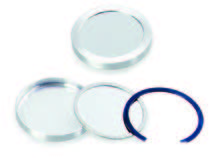*Troxler model 3450 and 3430/3440 Plus/Enhanced models are $549.00 due to software fee.
*Troxler model 3450 and 3430/3440 Plus/Enhanced models are $549.00 due to software fee.
A wide range of beta emitting nuclides are offered for counting and educational uses. Certification of all BF Series sources includes both contained activity and 2π emission rate. Sources are traceable to NIST with ±2% to ±5% accuracy at the 99% confidence level. Source configurations are surface conductive on all surfaces to enable their use in windowless proportional counters.
Beta Particle Standards—Type A and Type MF2.
See the following pages 42 and 43 for descriptions.
Split Source Set—BF-090SPLIT
This source is for use in determining coincidence corrections for G.M. counters. It consists of two plastic half
disks with a total overall diameter of 1” (25.4 mm). Each half-source contains a nominal 0.1 μCi (3.7 kBq) of Sr-90/Y-90.
Beta Standards Set—BF-200
This set consists of six nuclides covering the energy range 156-2282 keV (maximum): C-14, Tc-99, Cl-36, Pb-210/Bi-210, Pm-147 and Sr-90/Y-90. This set can be ordered without Lead-210. The C-14 source contains 0.1 μCi (3.7 kBq). The other nuclides contain 0.01 μCi (370 Bq). The sources are Type A or Type MF2, 1” (25.4 mm) overall diameter and 0.125” (3.18 mm) thick. Customer will specify source type. Please note that Pb-210 is not offered in the MF2 configuration. Included in each set is an empty mount, one 0.9 mg/cm2 aluminized Mylar window, one stainless steel disk, aluminum plug, aluminum support ring, and a Model BF-090SPLIT split source.
Sr-90 Sources
Sr-90 sources produced by EZIP are certified as to the contained activity of the Sr-90 only. Sr-90, a beta emitter,
is in equilibrium with the Y-90 daughter. Thus, a 1 μCi (37 kBq) Sr-90 source also contains 1 μCi (37 kBq) of Y-90. When comparing sources in similar geometries (i.e., similar backing, cover and source detector distance) good results should be obtained. Sr-90 has an average beta energy of 196 keV and Y-90 has an average beta energy of 934 keV, thus care must be taken when comparing sources of substantially different geometries since effects such as backscatter and window absorption must be considered.
Beta Particle Standards—Type A
The active material is uniformly distributed over the surface of a 0.937” (23.8 mm) diameter foil and sealed in an aluminum mounting ring under a 0.9 mg/cm2 aluminized Mylar window for most nuclides. The active diameter of the source is 0.805” (20.4 mm). Special absorbers may be included under the window to filter undesirable low energy radiation. This configuration is most useful for determining efficiencies of G.M. and windowless counters used for beta assaying evaporated liquid samples. The overall source diameter is 1” (25.4 mm) and 0.125” (3.18 mm) thick.

1) Positron emission from Ga-68.
2) This long-lived P-32 standard is the beta emitting P-32 daughter of the long-lived Si-32 parent. The standard mounting for this source is the A capsule with a 0.002” (0.051 mm) AI window. This window will absorb more than 60% of the Si-32 225 keV betas and less than 5% of the P-32 betas. Standards are prepared with the P-32 in equilibrium with the parent Si-32.
Beta Particle Standards—Type MF2
This is a “scatterless” configuration in which the activity is applied as a 0.12” (3 mm) spot centered between two laminated 0.9 mg/cm2 aluminized Mylar foils. The source is supplied in a removable aluminum holder. In the holder the source has an overall diameter of 1” (25.4 mm) and a thickness of 0.125” (3.18 mm). Out of the holder the source is 0.937” (23.8 mm) in diameter with a thickness of approximately 0.030” (0.76 mm).
This configuration is most useful for the precise determination of G.M. and proportional counter efficiencies, and as an educational tool for the verification of the inverse square law, as well as demonstrating back-scatter phenomena. Additional beta sources can be found on pages 55–65 including disk standards suitable for use with low background counting systems and 3.94” x 3.94” (100 mm x 100 mm) distributed beta sources for instrument calibration and dose assessments.
